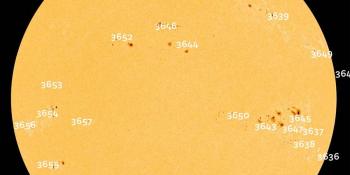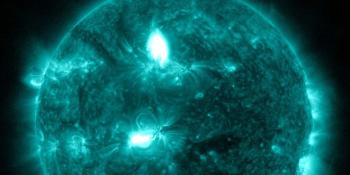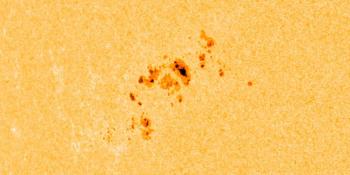Viewing archive of środa, 11 lutego 2004
Raport aktywności słonecznej
Any mentioned solar flare in this report has a scaling factor applied by the Space Weather Prediction Center (SWPC). Because of the SWPC scaling factor, solar flares are reported as 42% smaller than for the science quality data. The scaling factor has been removed from our archived solar flare data to reflect the true physical units.
Raport aktywności słoneczno- geomagnetycznej 2004 Feb 11 2200 UTCPrzygotowane przez NOAA © SWPC i przetworzone przez SpaceWeatherLive.com
Połączenie raportów USAF/NOAA o słonecznej i geofizycznej aktywności
Numer SDF 042 wydany w 2200Z na 11 Feb 2004IA. Analiza aktywności regionów słonecznych i aktywność od 10-2100Z do 11-2100Z Solar activity has been very low. Regions 549
(N12E79), 551 (S08W55) and 555 (S14E45) produced a few B-class
flares. No significant changes were observed to regions on the
visible disk. New Region 556 (N16E22) was numbered today.
IB. Prognoza aktywności słonecznej
Solar activity is expected to be low.
Regions 554 and 551 may produce C-class flares. There is a slight
chance for an isolated M-class flare.
IIA. Podsumowanie aktywności geofizycznej 10-2100Z do 11-2100Z
The geomagnetic field has been at quiet to minor storm conditions. A
solar sector boundary crossing was observed at ACE about 10/2320
UTC. ACE solar wind speed increased steadily from 380 km/s at
11/1600 UTC to 450 km/s at 2200 UTC, indicating that the earth may
be entering an expected coronal hole high speed wind stream.
Periods of southward Bz occurred from 1100 UTC to 1800 UTC and
resulted in increased geomagnetic activity towards the end of the
period.
IIB. Prognoza aktywności geofizycznej
The geomagnetic field is
expected to be at quiet to minor storm levels on 12 and 13 February
as a coronal hole high speed stream moves into geoeffective
position. Activity should subside to quiet to active levels on 14
February.
III. Prawdopodobieństwa zdarzenia 12 Feb do 14 Feb
| Klasa M | 20% | 20% | 20% |
| Klasa X | 05% | 05% | 05% |
| Proton | 01% | 01% | 01% |
| PCAF | green | ||
IV. Przepływ 10,7 cm z Penticton
Zaobserwowano 11 Feb 114 Przewidywane 12 Feb-14 Feb 115/115/115 Średnia z 90 dni 11 Feb 121
V. Indeks geomagnetyczny A
Zaobserwowano Afr/Ap 10 Feb 005/009 Szacowane Afr/Ap 11 Feb 010/022 Przewidywane Afr/Ap 12 Feb-14 Feb 015/020-015/020-012/020
VI. Prawdopodobieństwa aktywności geomagnetycznej 12 Feb do 14 Feb
| A. Średnie szerokości geograficzne | |||
|---|---|---|---|
| Aktywne | 30% | 30% | 25% |
| Słaba burza | 20% | 20% | 15% |
| Bardzo znacząca burza | 05% | 05% | 05% |
| B. Wysokie szerokości geograficzne | |||
|---|---|---|---|
| Aktywne | 35% | 35% | 35% |
| Słaba burza | 25% | 25% | 25% |
| Bardzo znacząca burza | 10% | 10% | 10% |
<< Idź do codziennego przeglądu
Najnowsze wiadomości
Najnowsze wiadomości z forum
What are these long and thin eruptions? 1AR 3637, 3638, 3643 89Unproven theories 341Space Weather Memes 338Filaments and prominences 55
Więcej tematówWesprzyj SpaceWeatherLive.com!
Wielu ludzi odwiedza SpaceWeatherLive aby śledzić aktywność słoneczną lub sprawdzić czy jest szansa na zaobserwowanie zorzy polarnej. Niestety, większy ruch na stronie oznacza większe koszty utrzymania serwera. Dlatego, jeśli jesteś zadowolony ze strony SpaceWeatherLive, zachęcamy do wspierania nas finansowo. Dzięki temu będziemy mogli utrzymać naszą stronę.

Fakty na temat pogody kosmicznej
| Ostatnie rozbłyski klasy X | 2024/03/28 | X1.1 |
| Ostatnie rozbłyski klasy M | 2024/04/25 | M1.0 |
| Ostatnia burza geomagnetyczna | 2024/04/19 | Kp7 (G3) |
| Spotless days | |
|---|---|
| Ostatni dzień bez skazy | 2022/06/08 |
| Monthly mean Sunspot Number | |
|---|---|
| marca 2024 | 104.9 -19.8 |
| Last 30 days | 133.9 +26.6 |


